
Award Program Mission
With these individual recognitions, we honor all members of our engineering and applied sciences community, who, through excellence in mentoring and advising, have guided and nurtured students and colleagues, thereby sustaining our greatest professional resource and ensuring future leadership, stewardship and success.
Program Vision
In celebrating excellence in mentoring and advising, we honor those exemplary professionals who have significantly and consistently supported the personal and professional development of their students and colleagues. They have enduringly engaged minds, elevated spirits and stimulated best efforts.
Those recognized have contributed diversely to our engineering and applied sciences community – serving as engineering educators or as professionals in industry, government or service organizations. They have ensured appropriate training within the profession; advised on thesis, proposal or project developments; assisted learners of all types to engage intellectually as individuals, and promoted progress in original work; provided guidance toward graduation or other advancement; helped resolve conflicts; and counseled on career opportunities. They have served as effective advocates and guides in both professional and administrative matters.
These exemplary mentors and advisors have shown true concern for the individual. They have been trusted counselors – providing an open mind, a compassionate ear, an enthusiastic smile, and, when needed, constructive criticism. They have created an effective environment for developing talents – helping others to see hidden possibilities, learn new ways of thinking about themselves, and open doors unseen without guidance. They have helped those less experienced develop into colleagues and colleagues into better professionals.
As true champions, they have created or enhanced institutional programs through their vision and passion for mentoring and advising, thereby demonstrating a lasting commitment to the personal development that is critical for professional and institutional success. They have earned respect and recognition for their contributions to their profession and to the greater community.

Awarding Institutions
INTERNATIONAL
An annual recognition for exemplary mentors located principally outside of the United States awarded through ASME.
A S M E
A not-for-profit organization promoting the art, science and practice of engineering and allied sciences throughout the world. ASME award honors started in July 2010, with global nominations and selections led by a diverse international committee.
U. S. NATIONAL
The Mentoring Award’s nationwide, annual recognition through Tau Beta Pi began in October 2006.
Tau Beta Pi
The U. S. national engineering honorary, with over 30 active regional alumni chapters and approximately 250 collegiate chapters throughout the nation.
UNIVERSITIES
Each supporting individual, endowed McDonald Mentoring Awards.
Duke University
Durham, North Carolina
Pratt School of Engineering awards began in April 2005.
Harvard University
Cambridge, Massachusetts
Paulson School of Engineering and Applied Sciences (SEAS) honors started in November 2008.
Johns Hopkins University
Baltimore, Maryland
Whiting School of Engineering honors started in May 2005.
Massachusetts Institute of Technology (MIT)
Cambridge, Massachusetts
School of Engineering awards began at MIT in July 2006.

Support from Initial Program Leaders
Each of these awarding organizations benefited significantly from active, insightful leadership during the period of establishing the Mentoring Award. Provided below are a few of the supportive ideas and comments garnered from the top leaders during this process.
The Mentoring Award program recognizes and honors diverse professionals in engineering and the applied sciences.
Each award consists of an individually engraved, three-inch bronze medallion and a significant financial award. The universities and Tau Beta Pi each add their annual honorees to perpetual commemorative plaques. The annual Tau Beta Pi award includes a matching gift in the honoree’s name to a university chapter of the association, and the Tau Beta Pi and ASME awards include travel stipends to designated award conferences.
For additional information, each institutions’ own web site and directory listings should prove helpful.
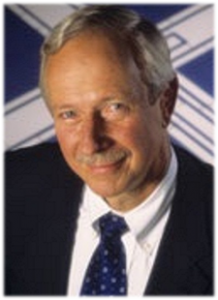
President Richard Brodhead, Duke University
“The connection between faculty and student remains at the heart of our educational mission, and these awards speak to the importance of that relationship. Your gift strengthens Duke in providing recognition for outstanding teaching, research, mentoring, and advising.
“Recipients of the medallions for these awards will be our finest scholar-teachers.”
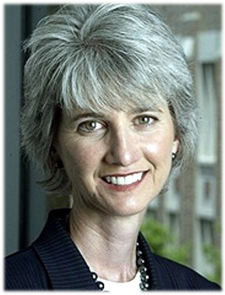
Dean of Engineering Kristina Johnson, Duke University
“Your gifts enable the Pratt School of Engineering to recognize outstanding faculty contributions to undergraduate and graduate teaching, mentoring, advising and research… Just as important…is an affirmation to Duke’s students that they are joining a professional community of distinction and commitment.
“For both his passion for engineering education and his focus on mentoring and advising undergraduate students, Dr. Michael Gustafson [Duke’s first honoree] clearly personifies the spirit of the Capers and Marion McDonald Award for Excellence in Mentoring and Advising.”
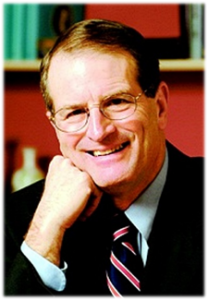
President William Brody, Johns Hopkins University
“Thank you for…the Capers and Marion McDonald Award for Excellence in Mentoring and Advising in the Whiting School of Engineering. This support will help provide well-deserved recognition of faculty who provide outstanding guidance to our Engineering students. I understand that you will also be providing award medallions to the recipients, and I am grateful for your thoughtfulness. This dedication to Hopkins helps keep this institution at the forefront of higher education and academic research.”
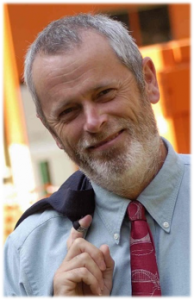
Dean of Engineering Nick Jones, Johns Hopkins University
“Thank you so much for…the Capers and Marion McDonald Award for Excellence in Mentoring and Advising. The Whiting School is very fortunate to be able to recognize…the importance of mentoring our Engineering students.
“Generations of our engineering students stepped up to confront the many challenges of the twentieth century. Your timely support is an investment in our latest faculty and students who continue to discover and apply pioneering solutions to the contemporary issues before us. You are helping the Whiting School provide an engineering education with an edge – the edge necessary to meet the demands of the twenty-first century. I understand that you both will be coming to campus…for lunch with Lester Su [Johns Hopkins’ 2007 honoree] before the Convocation. I hope to see you then, and once again, thank you for your commitment to Engineering at Johns Hopkins.”
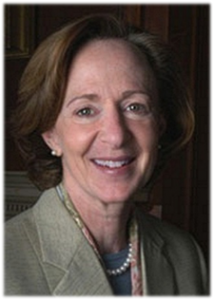
President Susan Hockfield, M I T
“Thank you so much for…the handsome medallion… I am delighted that you enjoyed the campus visit and that you welcomed the opportunity to become better acquainted with Tom [Magnanti, Dean of Engineering] and Phil [Clay, MIT Chancellor].
“I deeply appreciate…the Capers and Marion McDonald Award in the School of Engineering. Your commitment both to MIT and to the importance of mentoring in the educational experience is exemplary. I know that Tom Magnanti is especially…looking forward to selecting the first award recipient in June. Once again, I send my thanks…and my best wishes for continued success…”
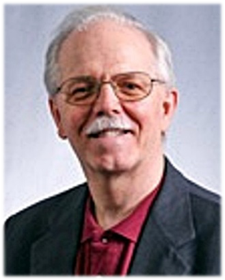
Dean of Engineering Thomas Magnanti, M I T
To “Bob [Cohen, MIT’s first honoree], …this award is presented to a faculty member in the School of Engineering, who – through tireless efforts to engage minds, elevate spirits, and stimulate high quality work – has advanced the professional and personal development of students and colleagues…
“You have been characterized as a mentor par excellence. You have contributed widely to our engineering community. In addition to successfully advising and mentoring a large group of your own graduate students, you have mentored a decade of graduate students while serving as the department’s Graduate Officer. You have advanced the professional and personal development of many more students and colleagues… across the Schools of Engineering and Science.
“You have earned much respect and recognition for your contributions to the profession, and to the greater community. We are proud to present you with this award for your many years of dedication and commitment to your students, to your colleagues, and to MIT.”
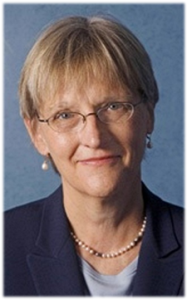
President Drew Faust, Harvard University
“Although Harvard over the decades has tended not to trumpet its own work in engineering and technology, it’s clear that it has been home to some extraordinary leaders in that domain. We can only imagine what the future may hold, now that engineering will take the more visible and central seat at our University’s academic table that its importance demands.”
“Now and in the future, our faculty, students, and staff can look forward to pursuing the marvels of modern technology as members of a full-fledged school… We can foresee that our new school will, in decades to come, accomplish remarkable things in the realm of the utterly unforeseeable.”
“… Harvard engineering – Harvard’s new School of Engineering – is all about building bridges. Bridges that connect basic with applied science, and applied science with technology. Bridges that connect science and technology with questions of ethics, of public policy, of how societies progress and how people live and work in our new century. Bridges that connect our new school with an array of other Harvard professional schools – from business to medicine, from design to public health, and beyond. Bridges that connect the University to industry – and to an array of consequential challenges facing the larger world.
“Bridges that connect our faculty with our students, and that join the rigorous pursuit of new knowledge with the education – indeed the inspiration – of those who come here to learn. And who constitute the next generation of scholars and engineers.”
Also, “Thank you very much for sharing a copy of the Capers and Marion McDonald Award for Excellence in Mentoring and Advising with me. Student mentoring is a vital teaching priority for Harvard …delighted that you established this prize at SEAS.”
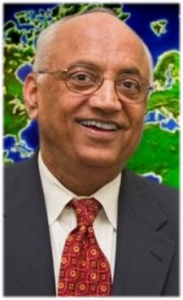
Dean of Engineering and Applied Sciences Venkatesh “Venky” Narayanamurti, Harvard University
“I am delighted…to express my sincere gratitude for your generous gift to establish the Capers and Marion McDonald Award for Excellence in Mentoring and Advising at the Harvard School of Engineering and Applied Sciences. It is a meaningful and thoughtful way to honor faculty who not only contribute so much to the field of engineering, but also take on the critical role of guiding and mentoring our community – be it students, junior faculty, or colleagues.
“As you know… I will spend the next few years developing new SEAS curriculum, and working actively to engage Harvard College students in science and engineering through expanded course offerings. I also expect to work more closely with my graduate students and post-docs on nanostructure physics. I have always considered working with Harvard students a privilege, and I am excited that in the coming years I can place a greater personal focus on teaching and mentoring.”
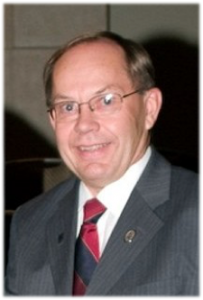
Executive Council President, Dr. Larry Simonson, P.E.; Tau Beta Pi
“On behalf of Tau Beta Pi, the national engineering honor society, I want to express appreciation for establishing the Capers and Marion McDonald Award to recognize the importance of mentoring to the engineering profession in general and to our organization in particular.
“The awarding of the medallion at our national convention each year gives each member an opportunity to reflect upon the many mentoring experiences that have benefited them in their life journeys, both personal and professional. It also serves as a reminder that as each of us continues to be mentored, we also need to accept responsibility to continue the tradition by serving as mentors for current and future engineers.
“The impact of the McDonald Mentoring Award will positively influence the members of Tau Beta Pi forever.”
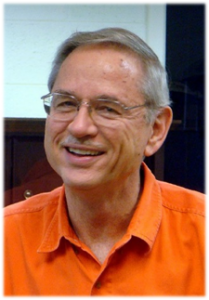
Executive Director James Froula, P.E.; Tau Beta Pi
“Capers, thank you very much for all of your vision and great support in establishing the new Mentoring Award, which we hope thrives during the millennium and the challenges that it brings.”
“We appreciate very much your support of the program, and I thank you most kindly for the beautiful medallion symbolizing the award that is displayed proudly and prominently in my office to remind me of the job to do. I understand the importance of professional mentoring and am grateful that you have included Tau Beta Pi in your vision to recognize some of the world’s outstanding mentors.”
“Congratulations to this year’s Tau Beta Pi – McDonald Mentor… His tireless efforts…inspire all of us.”
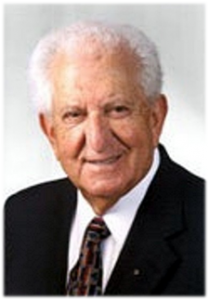
President Sam Y. Zamrik, Ph.D.; A S M E
“American political scientist Herbert Simon once said: ‘The engineer is more inclined than others to look for how life ought to be.’ Our stake in the future, literally, is because we have the skills to build it. What are our highest aspirations for the future? ASME has been looking at its role as convener, the innovative networks among members, and our global partnerships.
“One of the key partnerships that connect ASME members to the needs of the world was featured at the Congress keynote in November [2007] when Bernard Amadei, founder of Engineers Without Borders, spoke on engineering for the developing world. His message for the future focused on the worldwide transition to a more holistic and sustainable approach to engineering.
“ASME’s partnerships with global business expand networking opportunities for all ASME members. And we’ve made inroads this past year, through regional initiatives of key interest. For example, the Middle East [and] the Society’s cooperative relationships and work efforts in China.
“Another important theme to our global perspective is diversity maturity. In its November [2007] workshop, ASME’s Center for Leadership and Diversity explored this topic and how it impacts such key business areas as growth, performance excellence and corporate integrity. Last year, ASME reported on the diversity model for ASME, which challenged us to share a common vision and speak a common language. This is about working together on our vision and priorities to strengthen our profession and the leadership of ASME throughout the world. …about 15 percent [or approximately 18,000] of ASME members are from outside the United States.
“…it is clear that countries outside of the United States are an important source of membership for ASME and also constitute an important diversity component for our Society. Diversity can be looked at from the moral, legal, or equity points of view. As has been said by others, however, it is fundamentally important to recognize that a diverse engineering workforce brings more elegant engineering solutions that improve the quality of life. Ultimately, the case for diversity is made by its impact on the sustained growth of science and engineering. Effective management of diversity in an organization results in synergy that helps create productive working relationships in a pluralistic environment.
“In all these ways, ASME is trying to nurture its highest aspirations for a profession so full of promise. We do it by creating the kind of environment that opens communications, offers opportunities, and continues to look toward the future.”
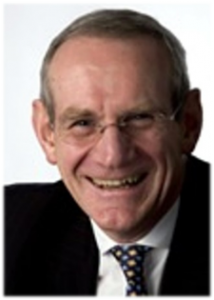
Committee Chair John Baxter, FREng, FRSE; A S M E
“I am delighted to be the first Chairman for the ASME McDonald Mentoring Award Committee and look forward to seeing the first submissions for the award early next year. Throughout my career I have always taken a great interest in the development of young engineers, and in my current role as the senior engineer in BP and also as the immediate past president of the Institution of Mechanical Engineers here in the UK, I have had some unique opportunities to mentor the next generation.
“Very best wishes to you and you wife in the future, and thank you again for sending me one of the medallions.”

Sponsors Capers and Marion McDonald
From Capers: “It was clearly my formative experiences that led to establishing this award program. Times enjoyed with a few great mentors instilled in me a keen sense of just how important these relationships are.
“Most often early in our lives, I think, many of us have had outstanding learning experiences with important people. These may have been intellectual or emotional connections. They are, however, always personal and constructive – and clearly memorable. As I grew older and reflected upon those many supportive times I was lucky to have had, I began to see a pattern. This helped me significantly in reaching out to others and trying to carry on their legacy of teaching and mentoring.
“My own outstanding mentors reflect, I also think, that social learning is an experience-based journey and a tutorial in the true sense. There were many of these outstanding people in my life, and, among others, they include the following:
“In the Carolinas: WalBern McDonald, my father and the personnel director for the Georgetown mill of International Paper Company; Rev. Mike Carmichael, minister for the church that sponsored the Scout troop where I became an Eagle Scout; Prof. Howard Clark, my academic advisor and best friend in the Biomedical Engineering Department at Duke University.
“In New England: Dr. John Hall, superb medical professional and chair of Orthopedic Surgery at Children’s Hospital Boston.
“In Northern California: Bert Voorhees, my first great boss and the general manager of Becton Dickinson FACS Systems; Dr. Mack Fulwyler, scientific director of Becton Dickinson FACS Systems; Randy Blair, a senior associate with Booz Allen Hamilton in San Francisco; Chuck Walker, the president of HP Genenchem, a joint venture of Hewlett-Packard and Genentech; Dr. Jurgen Vetter, German engineer and second president of Spectroscopy Imaging Systems Corporation (SISCO).
“In Maryland and New York: Sidney Knafel, the chairman of the board of directors of BioReliance Corporation, for which we completed an IPO in 1997 (NASDAQ: BREL) and where I served as president and CEO for 12 years.
“I also have found that as organizations mature, they often enhance their development as excellent places to learn and grow professionally by openly celebrating the importance of mentoring and advising, and, frequently, by putting in place formal programs supporting these activities.
“Marion and I now hope that – at least in a few places we have been – through these awards, each organization can better recognize and celebrate the contributions of the excellent mentors and advisors in their midst.”
Award Program Badges

Medallion – Design and Development
The concept and initial artwork for the award program’s medallion was developed early in 2005 by Capers McDonald at his home in Maryland. To bring the idea to fruition, Capers then worked closely through April that year with representative Tony Ullman and the team at the Medalcraft Mint in Wisconsin, and through them with talented medallic sculptor Gladys Gunzer, a North Carolinian then working in Arizona. Among other achievements, Ms. Gunzer has the distinction of being the first woman chosen to sculpt an official U.S. Presidential Inauguration Medal.
The central image on the obverse (front) of the Mentoring medallion is derived from a developmental sketch by the great European Renaissance designer, engineer, inventor and artist Leonardo da Vinci. This depicts an elder advisor and engaged youth. In adaptation for our contemporary award, the younger person was made to appear androgynous, neither particularly male nor female.
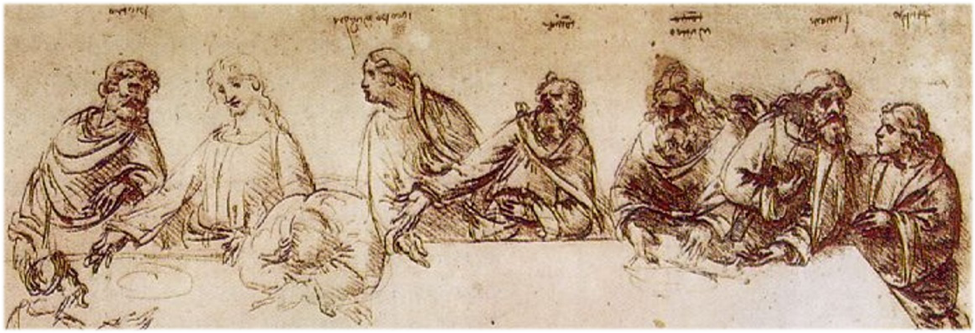
This unique artwork is based upon an original, red chalk study by Leonardo that he or a supervised student sketched in about 1495. At that time, Leonardo was developing early ideas for what became perhaps his best-know fresco, the Last Supper, which he completed in 1498. The study was located in 2005 among his drawings in the Gallerie dell’Accademia in Venice, Italy. The images found in this are not identically those used in the final fresco, however, and are not intended to represent historical figures. The flowing garments are thought to be appropriate for recognizing the timeless virtues of mentoring and advising, particularly for academic and learning-oriented settings worldwide.
The medallion was developed and minted at Medalcraft Mint in Wisconsin, a private mint with great success as high-relief die striking specialists. Since their founding in 1948, the Medalcraft Mint’s craftsmanship and quality have been recognized by industry experts with an unprecedented 20 first-place Gold Awards for metal striking excellence through 2005. Among other projects, they have been responsible for official U.S. presidential inaugural medals as well as medallions for universities, hospitals, governmental agencies, and many companies worldwide. Their team includes creative design and execution artisans as well as reliable business partners.
For the engineers among us: The Mentoring Award medallions are die struck from solid commercial bronze, a copper-zinc alloy designated either as Bronze 220 or C22000, and selected for this purpose based on metallic composition. In this case, that makeup is 89% to 91% copper, with a maximum of 0.5% lead and 0.05% iron, and the balance being approximately 10% zinc.
Prior to the minting process, computer-maintained original artwork was created and used by our medal sculptress to initiate production of the obverse and reverse dies. A talented and experienced artisan, she hand carved the obverse die in three-dimensional “bas relief,” employing a painstaking, multi-step process to ensure accuracy. The reverse design also was developed with care and a pantograph machine used by a skilled craftsman to cut that multilevel, two-dimensional die. Using the same hand tools and techniques employed by metal craftsmen through the centuries, an engraver added depth and detail to make the reverse images “come to life.” Both plaster and lead proofs were reviewed and approved by the McDonalds prior to the striking process.
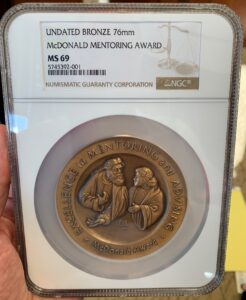 The approved dies were hardened by heat treating, each being subjected to temperatures above 1,700°F for up to eight hours. A Gauge 2 metal blank, previously cut to the desired 3-inch by 0.25-inch (approximately 76 mm by 6.4 mm) round, was placed in a coining press on top of one die. Up to 1,000 tons of pressure was used to “strike” the image into the metal, then excess material was removed in a trimming press. Using the corresponding die, this process was repeated for the other side. The edges were rounded in a lathe, and our unique edge marking was done, including the April 2005 date commemorating the first award and a copyright mark. After cleaning, each freshly minted piece was taken through an extensive hand finishing process, including adding a premium antique finish and light coat of jeweler’s lacquer on both sides to add highlights and protect the product from tarnishing and wear. Each finished medallion weighs over half a pound, about 0.54, which is 8.7 ounces or 247 grams.
The approved dies were hardened by heat treating, each being subjected to temperatures above 1,700°F for up to eight hours. A Gauge 2 metal blank, previously cut to the desired 3-inch by 0.25-inch (approximately 76 mm by 6.4 mm) round, was placed in a coining press on top of one die. Up to 1,000 tons of pressure was used to “strike” the image into the metal, then excess material was removed in a trimming press. Using the corresponding die, this process was repeated for the other side. The edges were rounded in a lathe, and our unique edge marking was done, including the April 2005 date commemorating the first award and a copyright mark. After cleaning, each freshly minted piece was taken through an extensive hand finishing process, including adding a premium antique finish and light coat of jeweler’s lacquer on both sides to add highlights and protect the product from tarnishing and wear. Each finished medallion weighs over half a pound, about 0.54, which is 8.7 ounces or 247 grams.
One of the (unawarded) medallions has been registered by the Numismatic Guaranty Corporation (NGC) as a collectible medal in superb grade Mint State (MS) 69 condition, as shown.
Lapel Pins – Recognizing Leaders and Nominators as Well as Honorees
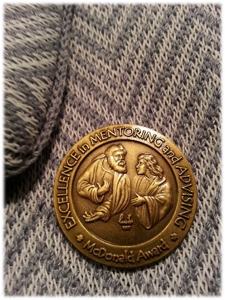
Each of the six awarding institutions now has a personal “thank you” for each nominator of record of a successful honoree. These are available for each honoree and institutional leaders as well. As pictured, these distinctive lapel pins are miniature replicas of the program’s award medallion. Each is one inch (2.5 cm) in diameter and is suitable for attachment on a lapel as well as to a backpack, purse or other accessory.
The pins are a tangible recognition of each nominator as an active participant in our extended community – already “visibly engaged” in mentoring and advising. They are intended to be worn as often as possible, to encourage dialogue about the importance of mentoring and advising in our classrooms and profession. Programs leaders also have been given desktop medallions and personal lapel pins.
Although first struck in 2013, these are available from the awarding institutions to all past nominators, honorees and program leaders. If you have not yet been contacted as a nominator or awardee of record, you are invited to contact the administrative staff at your participating institution. They look forward to hearing from you!

Medallion Ribbons – Unique Colors for Each Awarding Institution
Each of the six awarding institutions has a distinctive color pattern for its award ribbon. As pictured above, these patterns are immediately recognizable from each other and are based on the institution’s own preferred colors.
These have been the colors “as ordered” for the first several years of McDonald Mentoring Award ribbons from the original supplier, Medalcraft Mint. Additional or replacement ribbons can be purchased as needed. The Pantone® Matching System (PMS) or “standard” designations for these are as follows:
ASME – Two colors – PMS 661 Blue (or “Royal Blue”) and PMS “Standard” White.
DUKE – One color – PMS “Standard” White.
HARVARD – One color – PMS 187 “Crimson.”
JOHNS HOPKINS – One color – PMS 293 Blue (or “Reflex” or “Century” Blue).
M I T – Two colors – PMS 201 Red and PMS 424 Gray.
TAU BETA PI – Two colors – PMS 4625 Brown and PMS “Standard” White.
Medalcraft Mint – Medallion Dies and Each Institution’s Resupplier
Website: http://www.medalcraft.com
CONTACT: The Medalcraft Mint, Inc., 2660 W. Mason Street, Green Bay, WI 54303; Email: info@medalcraft.com, Voice: 800-558-6348
PAGE IMAGES (Not Yet Described):
Overview, Top Row: (L) Duke Associate Dean Linda Franzoni being congratulated by Capers McDonald in 2006, while the overall program’s first honoree, Dr. Mike Gustafson, adds his approval. (C) Family of Dr. Carter Kerk admiring the first Tau Beta Pi award, conferred in October 2006. (R) MIT Dean Tom Magnanti and Capers McDonald host 2006 honoree Prof. Bob Cohen in Boston.
Awarding Institutions: (L) Award program medallion, obverse (front). (C1) Fitzpatrick Center for Interdisciplinary Engineering, Medicine and Applied Sciences (CIEMAS) at Duke University. (C2) Mason Hall Computational Science and Engineering (CSE) facility and Homewood Campus Welcome Center at Johns Hopkins University. (C3) Great Dome and Killian Court at MIT. (C4) Maxwell-Dworkin Hall at Harvard University, a SEAS facility named for the mothers of Microsoft founders Gates and Ballmer. (C5) Tau Beta Pi “Bent” near association’s headquarters on University of Tennessee campus. (R) ASME and ASME Foundation logos.
Sponsors: (L) 2011 MIT honoree, Prof. Gang Chen, with Marion and Capers McDonald. (C1) Overall award program’s first honoree, Dr. Mike Gustafson, with the McDonalds. (C2) Award medallion, reverse. (C3) MIT 2010 honoree, Dr. Olivier de Weck, with the McDonalds. (R) The McDonalds in California.
Award Program Badges, Top Row: (L) Finished medallion in one type of display case. (C1) Self portrait of Leonardo da Vinci. (C2) Intermediate plaster cast of the obverse (front) of award medallion in development. (C3) Hardening of dies by heat treating at Medalcraft Mint. (C4) Press “striking” of a medallion. (R) Finished award medallion, reverse.
